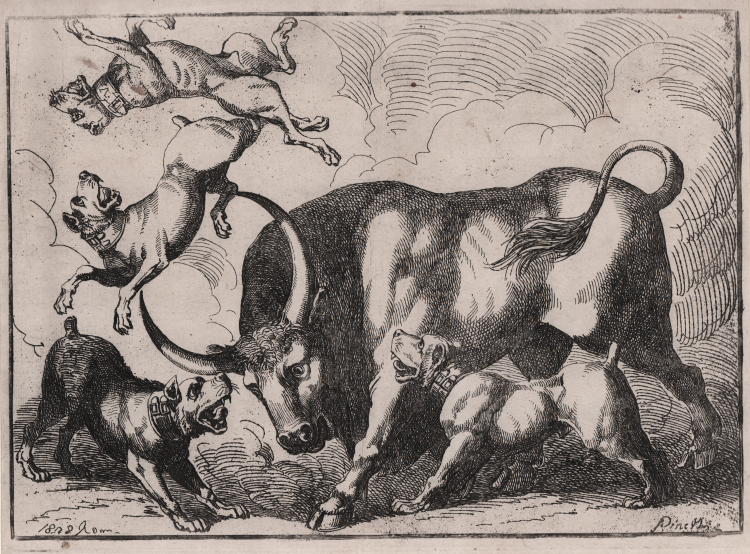



| Reference: | S12086 |
| Author | Bartolomeo PINELLI |
| Year: | 1828 |
| Measures: | 360 x 270 mm |


| Reference: | S12086 |
| Author | Bartolomeo PINELLI |
| Year: | 1828 |
| Measures: | 360 x 270 mm |
Etching, 1828, dated and signed in plate at bottom.
Magnificent proof, printed on contemporary paper, with margins, in excellent condition.
Very rare etching-not described in the catalog of the exhibition Bartolomeo Pinelli e il suo tempo 1781-1835 (M. Fagiolo and M. Marini, 1983)-depicting the famous "Roman bullfight," the festival of the stockade that was held during Carnival.
The stockade is something similar to a Spanish bullfight, but it was organized quite differently. The term fence clearly refers to the wooden fence that was erected in the people's square to divide the site of the action from the spectators, forming special bleachers for them so as to constitute a fictitious "amphitheater."
The fences were of two types: with oxen, dogs and men, or with oxen and dogs only. During "the hunt," trained dogs would attempt to immobilize the oxen by biting off their ear root, while the oxen would fend them off with horns. When man also intervened, however, as was the case in Rome, it was referred to as "jousting," where the man participated with feats and acrobatics on the animal excited and agitated by the dog, which was then stuck with a sword. The "jousters" were mostly local butchers, who challenged outsiders, amateurs and professionals, known as "ercoli" or "alcidi," among whom it is said they excelled above all the inhabitants of Terni.
The procedure of the game was fairly uniform in the Papal States. The fence was closed at 12 o'clock, the bulls were numbered and placed in the arena one at a time. A dog, trained to bite the ear of the ox, was then thrown against them. The winner was the one who first managed to pull off the ear, although it was not uncommon for the ox to gore the dog with its horns and disembowel it.
The festivals of the stockade in Rome are narrated by Gioacchino Belli.
Bibliografia
Sergio Anselmi, Il Gioco dello Steccato nello Stato Pontificio, in "Quaderni storici delle Marche," Vol. 1, No. 3 (3) (September 1966), pp. 440-451; Alberto Fiorani, Lo steccato o caccia del bove, Ostra Vetere, 1999.
Bartolomeo PINELLI (Roma, 1781 - Rome, 1835)
|
Italian printmaker, painter, sculptor and draughtsman. He learnt the rudiments of sculpture from his father, a maker of cheap religious statuettes. This early training encouraged Pinelli to emphasize plasticity and expression over the Neo-classical values prevalent in Rome. Although only a few of his terracotta figures survive however, he did produce a volume of etchings, Gruppi pittoreschi (Rome, 1834), depicting rustic groups. Its emphasis on naturalism and everyday subject-matter is also characteristic of his sculptures. Although he studied both at the Accademia di San Luca in Rome and at the Accademia di Belle Arti in Bologna, helped financially by Conte Lambertini, Pope Benedict XIV’s nephew, Pinelli was not interested in pursuing the traditional path to artistic success via religious or history painting. On returning to Rome in the late 1790s he chose to peddle his works at the cafés frequented by tourists.
|
Bartolomeo PINELLI (Roma, 1781 - Rome, 1835)
|
Italian printmaker, painter, sculptor and draughtsman. He learnt the rudiments of sculpture from his father, a maker of cheap religious statuettes. This early training encouraged Pinelli to emphasize plasticity and expression over the Neo-classical values prevalent in Rome. Although only a few of his terracotta figures survive however, he did produce a volume of etchings, Gruppi pittoreschi (Rome, 1834), depicting rustic groups. Its emphasis on naturalism and everyday subject-matter is also characteristic of his sculptures. Although he studied both at the Accademia di San Luca in Rome and at the Accademia di Belle Arti in Bologna, helped financially by Conte Lambertini, Pope Benedict XIV’s nephew, Pinelli was not interested in pursuing the traditional path to artistic success via religious or history painting. On returning to Rome in the late 1790s he chose to peddle his works at the cafés frequented by tourists.
|